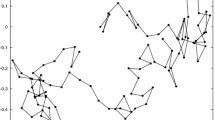Abstract
Biologists often define evolution as a change in allele frequencies. Consideration of the evolution of the pocket mouse will show that it is possible to have evolution without any change in the allele frequencies in a population (through change in the genotype frequencies). The implications of this for genic selectionism are then discussed. Sober and Lewontin (1982) have constructed an example to demonstrate the “blindness” of genic selectionism in certain cases. Sterelny and Kitcher (1988) offer a defense against these arguments which assumes a conventionalist approach to populations. The example considered here will be shown to offer a more plausible and far-reaching argument against the view that alleles can always be seen as the units of selection.
Similar content being viewed by others
References
Allee, W., Emerson, A., Park, O., Park, T. and Schmidt, K.: 1949, Principles of Animal Ecology, Philadelphia, W. B. Saunders.
Benson, S.: 1933, 'Concealing Coloration Among Some Desert Rodents of the Southwestern United States', U.C. Publications in Zoology 40, 1–69.
Blair, F.: 1943, 'Ecological Distribution of Mammals in the Tularosa Basin, New Mexico', Contributions from the Laboratory of Vertebrate Biology 203, 1–24.
Dawkins, R.: 1976, The Selfish Gene, Oxford University Press, Oxford.
Dice, L.R.: 1929, 'Description of Two New Pocket Mice and a New Woodrat from New Mexico', Occas. Papers Museum of Zoology, University of Michigan 203, 1–4.
Dice, L.R.: 1939, 'Variation in the Cactus Mouse, Peromyscus Eremicus', Contributions from the Laboratory of Vertebrate Biology 8, 1–27.
Dice, L.R.: 1940a, 'Intergradation Between Two Subspecies of Deer-Mouse (Peromyscus Maniculatus) Across North Dakota', Contributions from the Laboratory of Vertebrate Biology 13, 1–14.
Dice, L.R.: 1940b, 'The Theoretical Effectiveness of Adverse Selection', Contributions from the Laboratory of Vertebrate Biology 14, 1–6.
Dice, L.R.: 1947, 'Effectiveness of Selection by Owls of Deer-Mice (Peromyscus Maniculatus) Which Contrast in Color with Their Background', Contributions from the Laboratory of Vertebrate Biology 34, 1–20.
Godfrey-Smith, P. and Lewontin, R.: 1993, 'The Dimensions of Selection', Philosophy of Science 60, 373–395.
Sober, E.: 1984, The Nature of Selection, MIT Press, Cambridge, Mass.
Sober, E. and Lewontin, R.: 1982, 'Artifact, Cause and Genic Selection', Philosophy of Science 47, 157–180.
Sterelny, K. and Kitcher, P.: 1988, 'The Return of the Gene', Journal of Philosophy 85, 339–361.
Sumner, F.B.: 1918, 'Continuous and Discontinuous Variations in Peromyscus', Am. Nat. 52, 177–208, 290–301, 439–454.
Sumner, F.B.: 1921, 'Desert and Lava-Dwelling Mice, and the Problem of Protective Coloration in Mammals', Journal of Mammology 23, 75–86.
Williams, G.C.: 1966, Adaptation and Natural Selection, Princeton Univ. Press, Princeton, N.J.
Author information
Authors and Affiliations
Rights and permissions
About this article
Cite this article
Magnus, D. Evolution Without Change in Gene Frequencies. Biology & Philosophy 13, 255–261 (1998). https://doi.org/10.1023/A:1006541028421
Issue Date:
DOI: https://doi.org/10.1023/A:1006541028421




